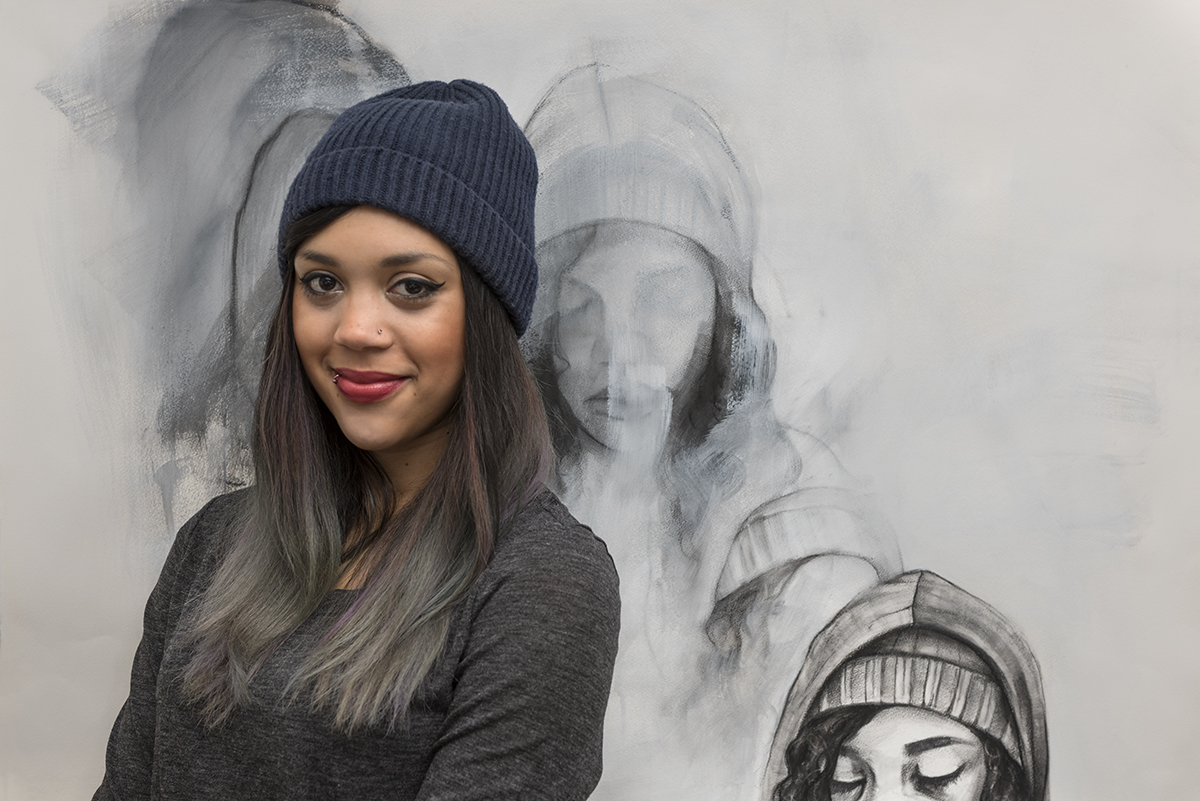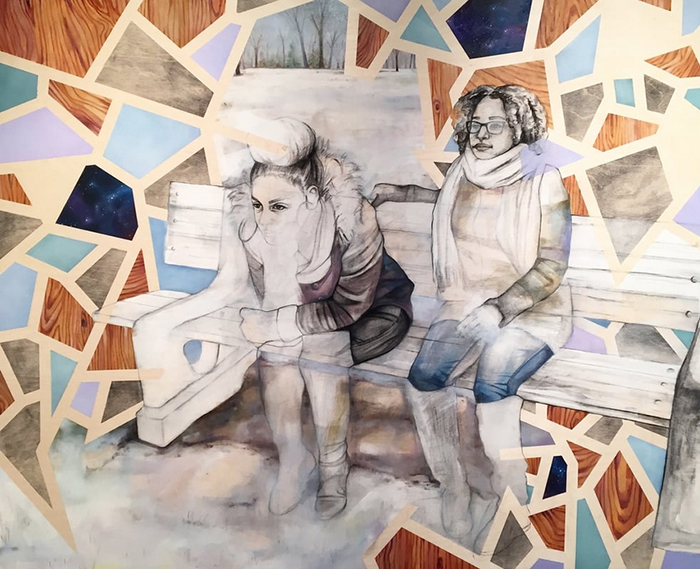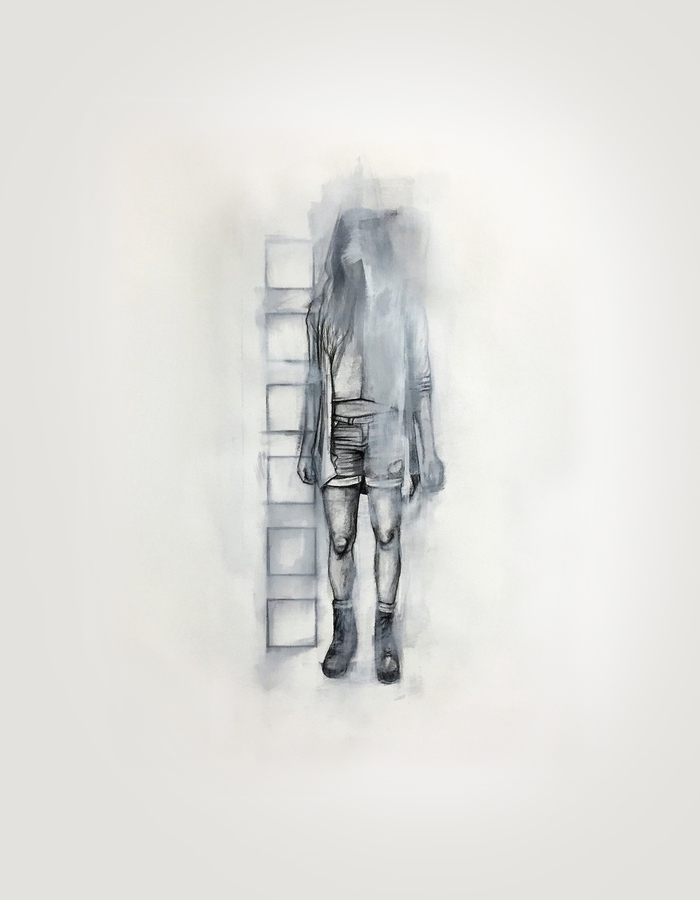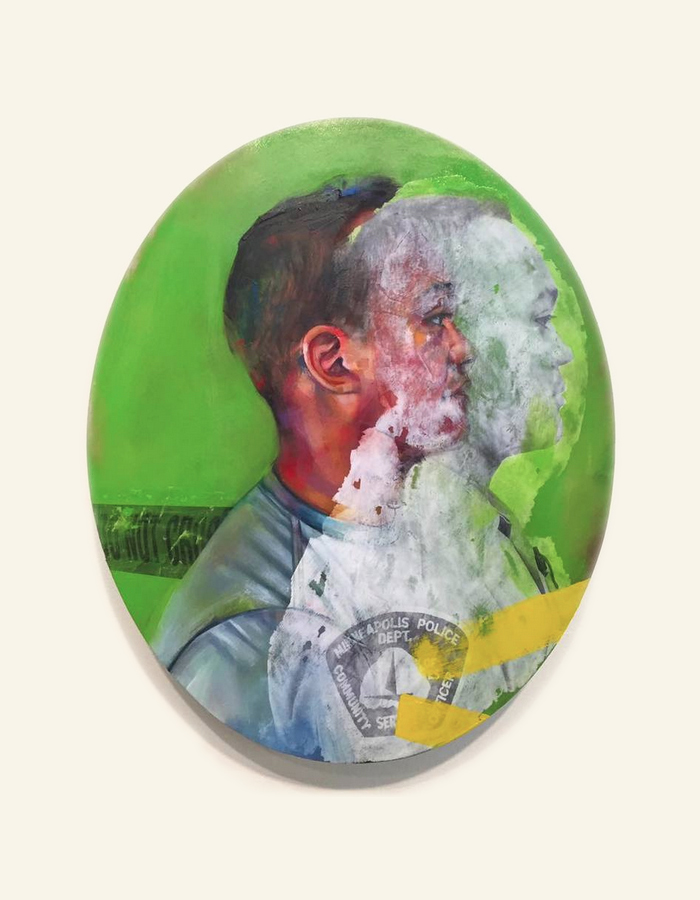
Interview: Leslie Barlow
Published May 2nd, 2016 by Russ White
Insights from MCAD MFA candidate Leslie Barlow on her painting, her success, her activism, and her cosplay.
Local painter and current MCAD MFA candidate, Leslie Barlow has a lot going on right now, from shows to grants to residencies and even NFL-sized commissions. She took time out of her busy schedule to talk with us about maintaining a successful studio practice, the secret to effective grant-writing, and how her work addresses identity and otherness.
 Leslie Photo by Rik Sferra
Leslie Photo by Rik Sferra
Russ White: You are currently in your second year as an MFA candidate at MCAD, you just had a show at the Hopkins Center for the Arts, you’ve participated in the most recent Made Here project, you have both a group show and your Thesis Exhibition coming up at MCAD, you just won a MN State Arts Board grant, you are planning for a fall residency in Spokane, Washington, and you are currently finishing up a commission for the Minnesota Vikings. That is a lot of irons in the fire! Can you tell me a little bit about your studio practice? It sounds like you must basically just sleep and paint, but there has to be a lot of admin-type work as well to stay ahead of deadlines and put proposals together. How do you balance that work with your painting?
Leslie Barlow: My studio practice is insane. I wouldn’t call it a well-oiled machine, but my schedule is pretty regimented to make sure I fit everything in and still get ample studio time. There are some days so packed that I have to actually schedule in times to eat or else I’ll forget! I’m hoping once I finish graduate school the schedule cramming will be a bit less severe, but I know that because I like to be involved in a lot of different things, I kind of have to accept the fact that I’m busy all the time.
I wish I could just sleep and paint (that sounds like the dream), but yes you’re right, a ton of admin work is involved to apply to shows and set up studio visits and manage a website, etc, not to mention the time it takes getting out to other art shows and talks regularly to see what your fellow people are doing and making. A teacher gave me some advice back in undergrad about the admin side of things- he said that you have to spend almost the same amount of time “managing” your art as you do actually creating the art. And it’s crazy because it’s kind of true. However, if you go into it knowing that the admin work is half the battle, and specifically allow time in your schedule to do it, it doesn’t seem as so much of a burden.
 Thoughts in a Winter Kaleidoscope, 48" x 60", Oil, gesso, and charcoal on panel, 2016
Thoughts in a Winter Kaleidoscope, 48" x 60", Oil, gesso, and charcoal on panel, 2016
RW: What is your process like when you start a painting? Do you usually have a good idea of where you’re headed when you begin?
LB: I think the answer is yes and no. Because I am a representational painter, I always have a sense of what the painting will look like because I need a source or model to directly work from. So whether I’m working from a live subject or working from a photograph I took of a subject, that informs what the pose, expression, or composition in the painting will look like. But many times I will deviate from the source imagery (this is especially true for the variety of colors I use in my work) or work from a few different images to compose one painting. Or halfway through the painting, I’ll change the trajectory entirely. For me it’s important to have a direction, but also allow space to alter that direction if the original idea isn’t working.
I am always researching and reading and taking in the world around me, and these things manifest themselves in my work. Many times it is deliberate: I want to depict a specific idea or particular event or a childhood memory. Other times I try to let the narrative work itself through the piece as I’m creating it, or I want things to be a bit more ambiguous.
 Installation view of Identity Series, 20" x 16" each Oil on Panel, 2015
Installation view of Identity Series, 20" x 16" each Oil on Panel, 2015
RW: Can you tell me about your proposal for the MN State Arts Board grant? Will your project be all new work?
Yes, the project will be all new work, but definitely in the same vein as the work I’m currently creating. I’m going to try not to get too long-winded here––but I’m very excited about my project proposal, and there are quite a bit of layers. My MN State Arts Board grant project will be a series of 8-10 large scale portraits (think 3 feet to 8 feet in size) featuring interracial families to highlight the 50th year anniversary of the Loving v. Virginia Supreme Court Case, which will be commemorated in 2017. I will be hosting a couple of public studio events during the months creating the series, and through the work and research, the paintings will be realized in a solo exhibition in the Twin Cities in early 2017, with a public artist talk and forum to follow.
Much of my current work uses the figure, narrative, and symbolism to talk about issues related to multiculturalism, “otherness”, and identity. I wanted to have a narrowed focus for this new body of work, and tie it into that historical event- Loving v. Virginia. Initially inspired by the controversial, racist backlash surrounding the 2013 General Mill’s Cheerios commercial featuring an interracial family, I realized it was extremely important to visually represent interracial families and people of mixed race as they are: normal and very much present. The Loving v. Virginia Supreme Court Case has been a moving and important part of my understanding the culture of discrimination surrounding interracial relationships and mixed race people. As I’m sure you’re aware, anti-miscegenation laws were a part of America since before the U.S. was established, and remained so until ruled unconstitutional in the 1967 court case. The case was brought by Mildred and Richard Loving, a black woman and a white man, who had been sentenced to a year in prison in Virginia for marrying each other. Unfortunately many racial tensions that were present during the case in 1967 are still present today. In addition, with the recent Supreme Court legalization of gay marriage, the questions of who we can love, what makes a family, and how equality is defined is even more relevant.
My main goal through this project is to make a body of work that articulates these themes and incorporates and represents our evolving community. Minnesota is changing. While we are not nearly as ethnically diverse as other states, diversity is at an all time high. According to the 2010 census, about 14% of residents are people of color, and about 2.4% of Minnesota’s population is multiracial, which is a 51% increase over the past decade. I wish to make visible a community that is the changing demographics of Minnesota, educate Minnesotans about families that are not the mainstream story, and bring attention to the important court case and civil rights moment in the racial history of the US. Using and working within the history of portrait painting allows me fertile ground to push the boundaries of our known visual language and inject that history with a new generation of faces and stories.
 Dissolve, 30" x 22.5", Charcoal and gesso on paper, 2015
Dissolve, 30" x 22.5", Charcoal and gesso on paper, 2015
RW: Do you have any insider tips on what you think makes for a successful grant proposal?
LB: Clarity of direction. I’ve applied for funding before and have not received it, and I think that was my biggest downfall. It’s important to be clear about what your idea is, why you want to do a project (why is it important to you as well as the community/people funding it), and how you are going to achieve the goals of your project. No extra jargon or unnecessary details that may take away or dilute your proposal.
RW: The social implications of racial and gender identity are topics of much discussion these days because of police shootings, presidential campaigns, and a much more vocal resistance to normalized privilege. Have these recent events and conversations affected your work? What do you see as the relationship between art and activism?
LB: Of course! These things ALL affect my work greatly! I think as an artist, I cannot help but reflect the world around me in my work. I’m making artwork in this time, in this place, and as a young woman of color from the Midwest. There are all of these lenses there.
As far as the relationship between art and activism...there's a lot of directions I could go with this question, there's a lot there, and maybe more than I'd like to get into right now. Art and activism historically have gone hand in hand, and socially-engaged/social-practice artwork is on the rise right now. I think it's hard to not make work reflective of the times that you're making the work in, and well, the times right now are tense. More then ever we need work that connects people, makes people question the status-quo, and represents historically marginalized voices and stories. I'm not sure if this really answers your question, but I think about the relationship of art and activism a lot and I just don't have a concrete answer or position... just a rambling stream of thoughts.
 Do Not Cross, 24.5" x 20" oval, Oil and photo transfer on panel, 2015
Do Not Cross, 24.5" x 20" oval, Oil and photo transfer on panel, 2015
RW: As a working artist about to finish graduate school, do you see yourself making art full time in the future?
LB: I would love to be able to make art full time, that’s the goal. But even so, I still want to have my hands in a bunch of different projects outside of my personal studio practice. The relationship between art and community is very important to me, and I like to work directly with people. I currently work at a newer gallery (we’re going on two years!), Waiting Room in the Loring Park area downtown Minneapolis, and I love that I get to assist other artists regularly and help facilitate meaningful conversations with visitors and the community. I definitely want to continue working in art spaces, or arts non-profit, and I could see myself teaching in the future as well…
RW: Overall, what do you think of the Twin Cities art scene?
LB: It’s tight-knit, supportive, and vibrant.

Two Grandmas, 84" x 48", Oil, acrylic, charcoal, and photo transfer on panel, 2015
RW: Finally, and perhaps most importantly, what did you think of Episode 7? (This can be off the record if you prefer, just curious from one Star Wars nerd to another.)
LB: This better not be off the record!! Ha! This is obviously the most important part of this interview. I mean, I don’t think I can accurately describe my excitement and feelings for where Episode 7 is leading us in the Star Wars universe, but yes I freaking loved it (even if it felt a bit too "familiar", I'm happy it actually felt like a Star Wars movie), and yes I’m thinking about how to incorporate something from Episode 7 into my cosplay rotation this year. I don’t want to give any other details away… just come find me at Wizard World’s Comic Con.
- Russ White
See Leslie's latest work, among others, at the MCAD MFA Thesis Exhibition opening Friday May 13th. She will also be a part of the next Made Here series as well as having work at All My Relations Gallery in June for the exhibition Reframe Minnesota: Art Beyond a Single Story. More details on these exhibitions and events soon. Visit lesliebarlowartist.com for more of Leslie's work and to learn more.
We can't do it without you.
Help keep independent arts journalism alive in the Twin Cities.